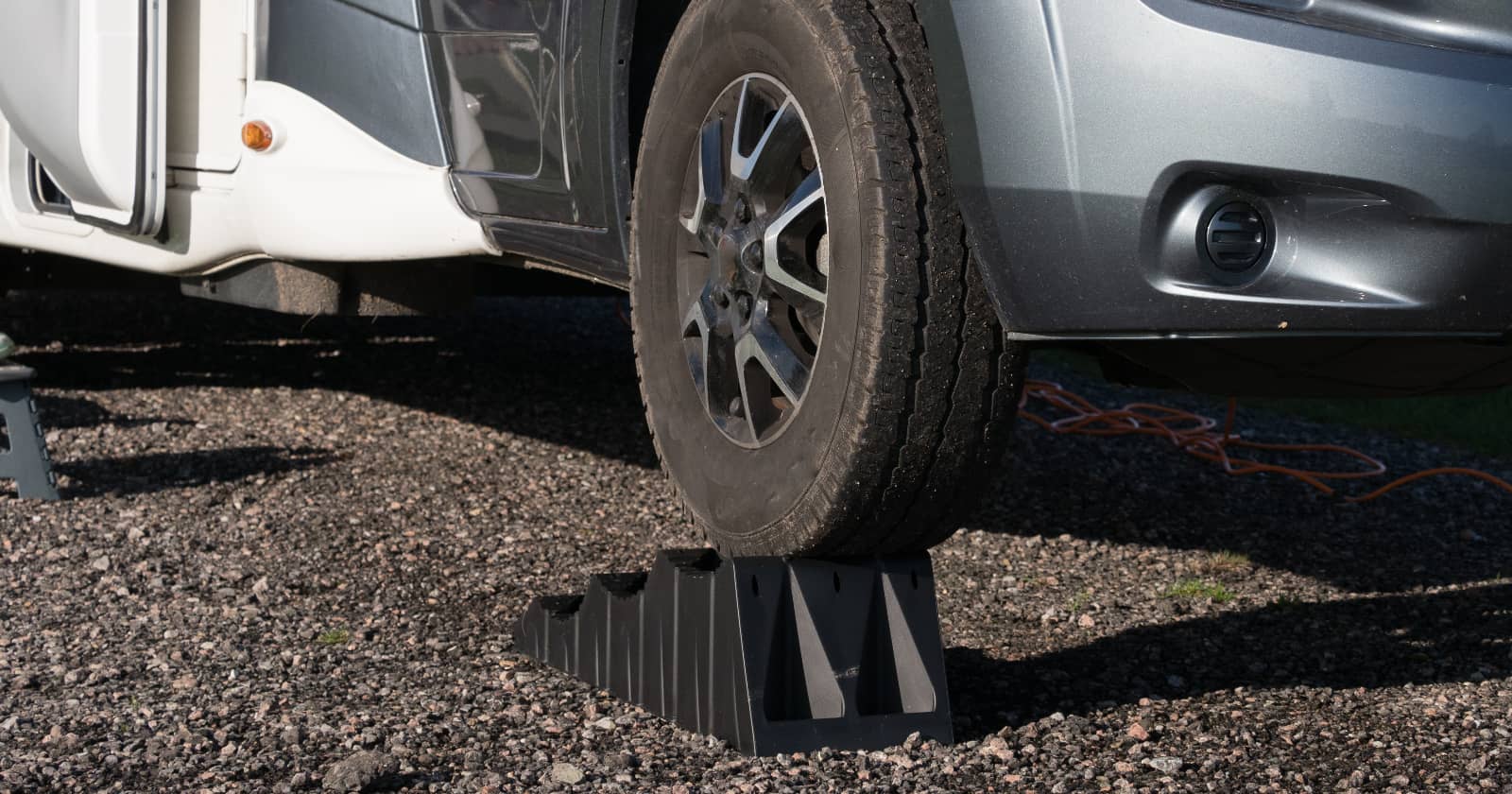Revolutionizing RV Stabilization With SnapPads
It’s not often that a new product shows up and totally shakes the whole RV industry. While SnapPads aren’t exactly brand new, they’ve introduced more and more models to fit a more extensive collection of RV leveling systems. So if you’ve had a look at RV SnapPads before and they didn’t have your size, it’s time to take a second look!
What is an RV SnapPad?
RV SnapPads are rubber protectors that snap onto your RV’s leveling jacks and offer a variety of benefits for your rig. They are the first and only permanent jack pads, meaning you only have to install them once, and they’ll stay in place.
SnapPads are designed to help your travel trailer feel more stable when set up with your jacks down. In addition, they protect the metal material that your jacks are made of. Traditionally, people have used plastic or wooden jack stabilizer blocks. However, these can be complicated and time-consuming to set up. These pads are made out of recycled rubber tires. So they not only protect your RV but also help protect the planet by reusing truck tires that would typically end up in a landfill.
Who Needs RV SnapPads?
These handy jack protectors are ideal for any RV owner whose rig has stabilizer jacks. That includes all fifth wheels plus many other trailers, motorhomes, and truck campers.
SnapPads are perfect for those who want to minimize setup and takedown time at campsites and when storing their rig. Simply put, if you like to make your life easier, then SnapPads are for you!
The Benefits of RV SnapPads
The benefits of SnapPads are much more than meets the eye! While they’re clearly convenient and easy to use, there are additional perks to using these over other stabilizer blocks.
Stay in Place
These pads are designed to stay in place, so they’re entirely hassle-free after one installation! You no longer have to get under your rig each time you set up or take down camp, saving you lots of time (and probably some back aches).
“For your peace of mind, the pads do not fall off; they must be knocked, bumped, or scraped off. During third-party testing, all models of our SnapPads are subject to and must pass something called a “shake test” to see what speeds are required to experience a loss. Rest assured that the speeds necessary to knock the pads off while driving is not allowed on public roadways.”
-SnapPad Q&A
Improve Stability
The main objective of SnapPads is to enhance the stability of your rig when it’s set up. This is achieved by adding one inch of thickness plus between 40 and 316% of your jack’s footprint (depending on your leveling system). This extra area enhances stability on all terrain, including sand, grass, mud, gravel, and cement.
RV SnapPads Withstand Extreme Conditions
SnapPads have been tested under extreme temperature conditions and have proven to remain unaffected from -40°F to +120°F. That means you don’t have to stress about your SnapPads functioning properly from the deserts of Arizona to snowy Montana.
In addition, they’re meant to withstand oil, UV exposure, and many other environmental hazards.
Free Up Storage Space
With this permanent solution for jack stabilizers, you won’t have to use up valuable storage space for plastic or wooden ones that must be set up each time.
RV SnapPads Save Time
These permanent jack stabilizer pads mean that you don’t have to crawl under your rig every time you pull into a new RV park. Instead, simply lower your jack stabilizers when you set up camp and raise them when you’re ready to go. Your SnapPads will stay in place, saving you tons of time.
Work on Many Surfaces
SnapPads are specifically engineered to conform to uneven terrain that is commonly found in campgrounds like gravel or cement. They’re anti-slip, making them ideal for slick surfaces like ice as well. On soft earth, they will help prevent your metal jack feet from sinking into the ground. On the other hand, they will protect your jack feet on rough surfaces like asphalt and cement. They even have water drainage channels to help protect the SnapPads when used in rain or snow.
Drawbacks of SnapPads
We were pressed to find any downsides of SnapPads! Their ease, convenience, design, and price points make them valuable for any RV owner. However, there are a few limitations.
There’s No One Size Fits All
The reason that SnapPads function so well is that they’re specifically designed for specific jack feet sizes, but there are a lot of different varieties on the market! Having SnapPads that are designed specifically for your rig is definitely a benefit. However, if you trade in your rig for something different, you’ll need to buy a new set of SnapPads.
Not Every Rig is on the List (Yet)
SnapPad has a list of common RV makes and models and can connect you quickly with the right set for your rig. However, there are countless varieties of jack systems out there, so not every rig is on their list. But that doesn’t mean that SnapPads won’t work withyou. They have a detailed guide on how to find the right SnapPad package. Even better, if you’re in doubt, they have an excellent customer service department that can help you find the right system for you!
How Do SnapPads Work?
These permanent jack stabilizer “shoes” only need to be installed once, and then they stay in place on your RV. They come in many different sizes and shapes, so you can find a SnapPad that fits your RV like a glove.
The installation is super easy and usually takes less than 15 minutes.
- Simply lower your jacks to a few inches above the pad.
- Get the RV SnapPad centered underneath your jack foot.
- Keep lowering the foot until you hear the pads snap into place. Voila!
Now the pads will stay in place anytime you raise or lower your rig’s jack stabilizers. So when you’re ready to leave, the pads stay on the foot, and when you’re ready to put them down, the pads are already in place.
Try SnapPads For Yourself!
A quick Google search will show you that there are a ton of happy SnapPad customers out there! With the overwhelming amount of benefits they offer, we’re sure once you try SnapPads for yourself, you’ll never go back to the time-consuming and clunky jack stabilizers of the past.
Have you tried RV SnapPads yet? Drop us a comment and let us know!



Just another “gadget” to sell to RV’ers that want to spend their money. I’ll stick to my wooden blocks that have a larger foot print and cost nothing but a little elbow grease. These thing come off at the least bit of bumps, and stick in the mud. Sorry, I have better things to spend our money on.
Bull feathers. The article said that the Snap Pads would not shake off until speeds way above the legal limits were reached. I had a class C that I would use blocks of wood but unless I was on cement or packed gravel, they would sink in. The blocks of pressure treated wood were wearing out or splitting. When we bought our class A Diesel pusher, installed a set of Snap Pads and don’t regret it one bit.
agree 100%
Dealer where I bought my class c said snap pad’s won’t work because of clearance problems. I have a 2011 Jayco Melbourne 29D.
I agree with Martin 100%. I don’t see how they can be a game changer. My wooden blocks have a much bigger footprint than any plastic pad.
They are not plastic. Read the article. They are made from recycled rubber.
Seemed like a paid infomercial
I have these on my 2015 Fleetwood Bounder Motor Home and have to say they are one of the items on my RV that I am extremely pleased with!!
Park on grass, gravel, soft asphalt? they are a game changer for motorhomes. Have them on my MH going on 3 years,, without doubt I’d buy them again.
I found a 4 ‘ x 8’ sheet of 1″ thick fir exterior plywood, cut a lot of 16″ x 16″ pads, knocked off the corners, painted with some off-color porch paint from the paint store ($ 5.00/gal), and now have 1″ or 2″ thick pads under our leveling and front jacks for under $ 100. They don’t take much room in the truck bed, are versatile, rugged, and can be placed where needed to even out the sites that have a few hollows. They have 60 % more surface area than my attached steel levelling pads. Also, I don’t worry about one flying off into following traffic or pedestrians, or getting stuck in some soft ground and stressing the jack motors. Spending a few extra minutes to place and retrieve these homemade pads has been worth it to me, especially as it promotes an inspection of the individual jacks and their mounts twice per stopover.
I’ve got them on my truck camper and they work Great!, I really watch the added weight I drag along with me and these are trouble free, they take care of themselves. I don’t have the added storage room that some may have to carry around blocks of wood, but the best thing about these is…if you need them, buy them, if not, you can move on! It’s your choice> Happy camping!
Love them on my Grand Design 346FLS.
No messing around with blocks and having to store them.
Hit the auto level and walk away, start working on electrical and water.
Reduces setup time significantly.
Yeah, they’re permanently attached until you go over the high railroad grade crossing. Save your money. Use “Lego” Blocks” or some wood pieces.
Still didn’t see exactly WHY i need them over anything else. So, the stay on. Other than that, just what am I buying. Theres not that much more surface area, so it can’t be stability. It’s not that much extra height to keep me from running out my jacks.
Just another sales pitch so people can make money. Must work, because we commented on this junk….
Snap pads may be nice for RV parks or campgrounds with relatively flat surfaces. However, I boondock 95% of the time and I rarely find perfectly level ground. I prefer blocks because I don’t want to extend my jacks to far so I try to place the blocks for minimal extension of the jacks. I believe it probably (I haven’t done experiments on this) reduces sideways stress on the extended jacks and allows the tires to maintain contact with the surface most of the time so better stabilization of the RV. YMMD
Wheels off the ground a big no no. Shows how much they know.
Great if you only camp on flat level spots. But if you are in an uneven space, you will still need blocks to take up the extra drop. More of a pocket changer than a game changer. The author must have been given a free set to write nice things about.